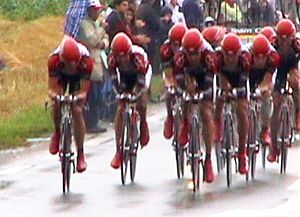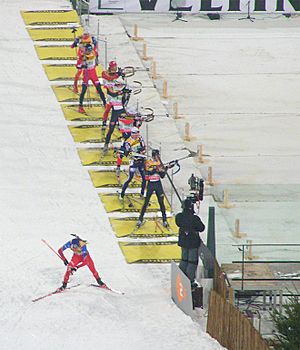Time trial facts for kids

A time trial is a type of race where athletes compete against the clock instead of directly against each other. In these races, each person or team starts at a different time. The goal is to finish the course as fast as possible. The winner is the one with the shortest time.
Time trials are common in many sports. These include cycling, cross-country skiing, biathlon, and rowing. They test an athlete's speed and endurance.
Contents
How Time Trials Work
In a time trial, athletes usually start one by one. There is a short gap between each start. This gap can be from a few seconds to a minute. This way, athletes are not racing side-by-side. They are racing against the clock.
Individual Time Trials
In an individual time trial, one athlete races alone. They try to set the fastest time on the course. This is common in cycling road races. It is also used in cross-country skiing and biathlon. In these ski races, skiers start every 30 to 60 seconds. These are called "interval starts."
Team Time Trials
Some sports have team time trials. In cycling, a team of riders races together. They work as a group to go faster. Riders take turns leading the group. The riders behind the leader are protected from the wind. This helps the team save energy and ride quicker.
Time Trials in Rowing
In rowing, time trial races are often called "head races." Boats start one after another, usually every 10 to 20 seconds. They race over a set distance. The crew with the fastest time wins.
Time Trials in Major Events
Time trials are often a key part of bigger competitions. For example, the Tour de France is a famous cycling stage race. It includes several time trial stages. These stages can decide who wins the entire race. They are exciting because every second counts.
Images for kids
-
Time trial "Souvenir Stefan Götz" at the 2nd ICFF, Marbeck, Germany, September 2007
See also
 In Spanish: Competición contrarreloj para niños
In Spanish: Competición contrarreloj para niños



